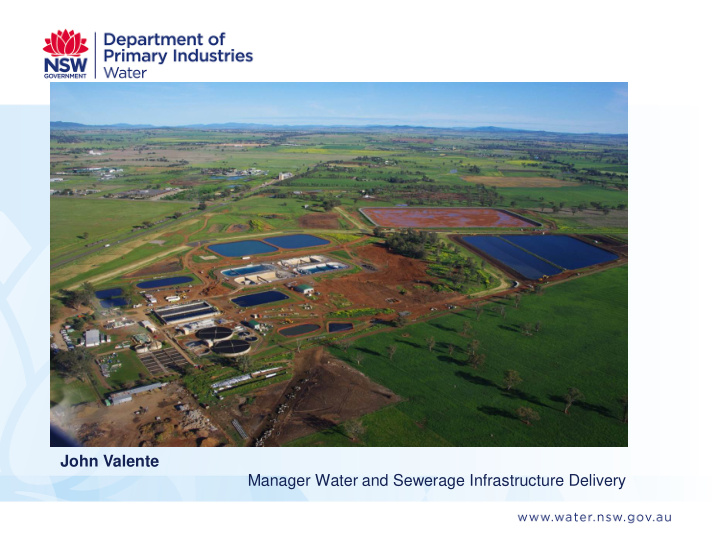



Click to edit Master title style John Valente Manager Water and Sewerage Infrastructure Delivery
Agenda 1. Background information 2. Department of Primary Industries (DPI) Water and our programs 3. Historical and recent issues affecting water security 4. The Future
Background • 92 Local Water Utilities (LWUs) in Regional NSW • Providing Water & Wastewater Services to 1.83 million people • Water and Sewerage asset replacement cost is approximately $26 billion
Background Infrastructure in regional NSW • 350 water supply systems • 306 water treatment works • 395 sewerage treatment works • 3,900 sewer pump stations • 116 dams/weirs • 38,000 + km water mains • 19,000 + km sewer mains
Background LWUs are required to • Plan • Price • Construct • Manage • Operate and maintain their water supply & sewerage systems
DPI Water Department of Primary Industries Water • DPI Water is responsible for surface and groundwater management and planning to ensure water security for NSW, • DPI Water ensures the available surface and ground water resources are shared equitably, and that water entitlements and allocations are secure and tradable. • DPI Water is responsible for the management of NSW’s water resources which is achieved through planning, policy and regulation. • Best-Practice Management Framework • Regulation under the Local Government Act of 1993
DPI Water Department of Primary Industries Water • Short-term and Long-term Water Security Improvement Projects for Regional Communities • Improve Water Quality and Supply to Regional Communities through • Technical advice and assistance to regional Local Water Utilities in order to deliver appropriate, affordable, cost- effective & sustainable water supply and sewerage services • Country Towns Water Supply and Sewerage (CTWSS) Program • Regional Water & Wastewater Backlog (RWWB) Program
Programs Country Towns Water Supply & Sewerage Program (CTWSSP) • Between 1996 and 2016, the NSW Government provided approximately $1.23 billion in funding for regional water & wastewater infrastructure • Up to 50 % subsidy for projects • More than 450 projects delivered in 20 years • This program ends on 30 June 2017
Effectiveness of the CTWSS program & BPM Framework • The Country Town Water Supply & Sewerage (CTWSS) program has been highly effective in servicing regional NSW communities. • The program together with the NSW Government’s Best-Practice Management Framework (BPM) has delivered key outcomes: – coverage for water supply - 98.0%, 1.81 million population. – coverage for sewerage – 95.6% (increased from 92.3% in 1996), 1.69 million population. – achieved efficient water use and limited the real increase in the water supply Typical Residential Bill (TRB) to 12% over the last 18 years.
Programs Regional Water & Wastewater Backlog Program (RWWBP) • This is a new capital works program announced in October 2016 • $110 million committed to clear “backlog” of projects in country towns • 32 Backlog projects have been approved
Backlog Project locations
Challenges The challenges we have are: • Ensuring that our water drinking quality remains at a high standard, • Capacity to meet water demand for growing populations, • Drought security, • Dam safety • Wastewater treatment. • Ageing assets • Skills in regional areas
Long-term Water Security Improvement Projects for Regional Communities Key threats to water security • Climate variability / drought • Growth in demand due to increase in population, industry • Environmental flow requirements Possible Projects • Additional infrastructure such as new dams, enlargement of existing dams, bores, desalination plants • Additional infrastructure to link major bulk water dams to major regional towns and piping of inefficient channels Direct Outcome/Benefits Achieved • Maintain continuity of water supply to regional towns • Enhance regional development and decentralisation
Improve Water Quality to Regional Communities Key threats to water quality • Addressing of risks outlined in the national drinking water guidelines • Protect waterways & quality of life with modern standards • Potential blue-green algal blooms and associated toxins Possible Projects • Provision of reticulated water supply & sewerage to high risk towns • Additional infrastructure to manage risk to drinking water quality • Modern critical infrastructure assets for remote communities & LWU’s facing financial hardship Direct Outcome/Benefits Achieved • Protection of public health • Minimised environmental risk
Infrastructure Planning and Delivery Typical Project Cycle : • Feasibility investigations, • Project management • Consultation, • Concept design • Environmental studies, • Environmental assessment, • • Yield modelling, Detailed design, • Integrated Water Cycle • Tendering phase, Management, • Construction • Financial modelling, • Commissioning, • Funds identification, • Post completion…. Typical timeframes for small infrastructure projects can be between 2-5 years. Most major infrastructure projects can take up to 10 years from conception to completion
The bottom line……… • Water is a finite resource with extensive competing demands • Robust strategic planning is vital • Collaboration, not just consultation, is required as early as possible for any proposed project • The NSW Government recognises the needs in regional NSW and is here to help
Recommend
More recommend